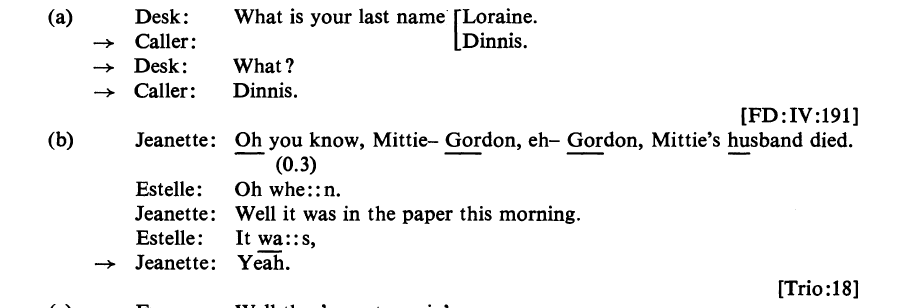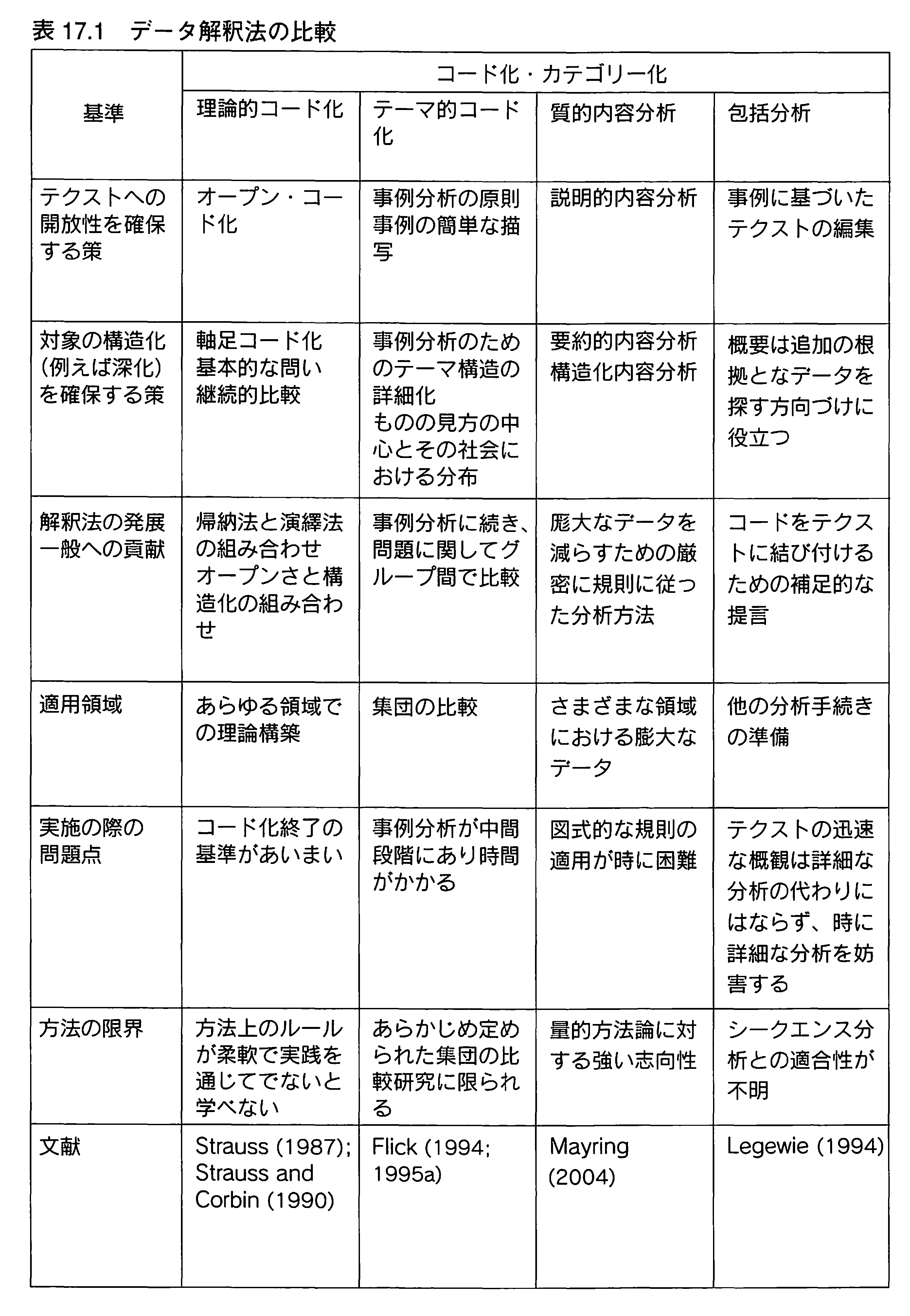On Qualitative Study and Ethnography:06

On Qualitative Study and Ethnography:06

 グループワー
クの課題 グループワー
クの課題1)インタビューにおける発語のシークエンスと、会話分析の資料である発語シークエンスの、共通点と相違点をあげて、比較検討しなさい。 2)イアン・パーカーは「『ナラティブ』とはアイデンティティの物語として自己を演じることである」 ('narrative' is the performance of the self as a story of identity.)(翻訳: p.98、原著:p.70)これは、みなさんが考える「ナラティブ」の定義とは異なるように思われる。まず、各人は、これまで思っていた「ナラティブ」を 定義してから、イアン・パーカーのこの定義の是非(イケてる?/イケてない?)をみんなで論じよう。 ※Ian Parker, Qualitative psychology : introducing radical research, Open University Press c2005(ラディカル質的心理学 : アクションリサーチ入門 / イアン・パーカー著 ; 八ッ塚一郎訳, 京都 : ナカニシヤ出版 , 2008 |
第6回 2017.05.22 /2018.05.21(各章の表題)
16.シークエンス分析
17.テキスト解釈法の概観
18.質的研究の基礎づけと価値基準
19.質的研究の執筆
■今日(今回)の教材は、こちら(with password):170522-Qualitative_2002-2017-6.pdf :
___________________
(各章と各節の表題)
16.シークエンス分析
17.テキスト解釈法の概観
18.質的研究の基礎づけと価値基準
19.質的研究の執筆
++++++++++++++
(各章と各節へのコメント)
16. シークエンス分析:シークエンスは繋がり・連なりのことでであり、それは会話や語り、あるいは言説の「連なり」のことだ。それを分析する。
16.1 会話分析 conversation analysis.
"Conversation analysis (CA) is an approach to the study of social
interaction, embracing both verbal and non-verbal conduct, in
situations of everyday life. CA began with a focus on casual conversation, but its methods
were subsequently adapted to embrace more task- and institution-centered interactions,
such as those occurring in doctors' offices, courts, law enforcement,
helplines, educational settings, and the mass media." - Conversation
analysis.
会話の順番取り:Sacks et al., 1974
Harvey Sacks; Emanuel A. Schegloff; Gail Jefferson, A Simplest Systematics for the Organization of Turn-Taking for Conversation. Language, Volume 50, Issue 4, Part 1 (Dec., 1974), 696-735.
single-word turns...

Single-phrese turns...

会話の終わり方: Schegloff and Sacks, 1974
++
会話機械(Bergmann 1981)あるいは、 会話分析機械(conversation analysis machine, M. Ikeda n.d.)
「会話分析による研究は形式上の詳細にこだわりすぎて全体像を見失う」(本書、p.249)
■イライザとの会話を会話分析してみよう!
→「総本家「イライザあるいはヴァーチャル・オードリー物語」」
●傍観者は、片側だけの発話しか聞き取れないコミュニケーション(→「遠
隔地対人コミュニケーション」)
16.2 談話分析(Discourse analysis)
"Discourse analysis (DA),
or discourse studies,
is the approaches to analyze written, vocal, or sign language use, or
any significant semiotic event./ The objects of discourse analysis
(discourse, writing, conversation, communicative event) are variously
defined in terms of coherent
sequences of sentences, propositions, speech, or turns-at-talk.
Contrary to much of traditional linguistics, discourse analysts not
only study language use 'beyond the sentence boundary' but also prefer
to analyze 'naturally occurring' language use, not invented examples. Text linguistics is a closely
related field. The essential difference between discourse analysis and text linguistics
is that discourse analysis aims at revealing socio-psychological
characteristics of a person/persons rather than text structure." - Discourse
analysis.
"Text linguistics is a branch of linguistics that deals with texts as communication systems.
Its original aims lay in uncovering and describing text grammars. The
application of text linguistics has, however, evolved from this
approach to a point in which text is viewed in much broader terms that
go beyond a mere extension of traditional grammar towards an entire
text. Text linguistics takes into account the form of a text, but also
its setting, i. e. the way in which it is situated in an interactional,
communicative context. Both the author of a (written or spoken) text as
well as its addressee are taken into consideration in their respective
(social and/or institutional) roles in the specific communicative
context. In general it is an application of discourse analysis at the
much broader level of text, rather than just a sentence or word." -Text linguistics.
■ニュージーランドにおける人種偏見
・「遺産としての文化」/「癒しとしての文化」
「私はマオリタンガが本当にとても好きなんです。ニュージーランドに独自のものですから。私はその保存に大賛成です(ええ)。いろいろな生き物 の種が絶滅するのを見るのが嫌なように、文化や言語や(ええ)その他のものが薄れてなくなってしまうのを見るのは嫌なものです(ええ)」(p.148). [Potter and Wetherell 1998](教科書:251ページ)1988?
Margaret Wetherell and Jonathan Potter, Discourse analysis and the
identification of interpretative repertoires, in "Analysing Everyday
Explanation:A Casebook of Methods, " Edited by Charles Antaki, Sage.
1988
Let us now look in a bit more detail at the makeup of these repertoires. Culture fostering presents arguments for the development of Maori culture. It appears to advocate multiculturalist social policy and the importance of Maori culture for New Zealand society. There are two major facets to it. On the one hand, it presents the view that Maori culture should be encouraged, fostered, protected and conserved because it uniquely and distinctively identifies New Zealand, and is a worthwhile culture in itself. For example:
(8) I'm certainly in favour of
a bit of Maoritanga it is something uniquely
New Zealand. I guess I'm very conservation minded and in the same
way as I don't like seeing a species go out of existence I don't like
seeing
a culture and a language and everything else fade out. (Shell)
On the other hand, culture
fostering presents the view that it is
important for the Maori people to have a sense of identity and history
or roots, in the way it is considered important for every person to have
a sense of identity or place. For example:
(9) I think the sort of Maori
renaissance, the Maoritanga, is important
because like I was explaining about being at that party on Saturday
night, I suddenly didn't know where I was, I had lost my identity ....
I
think it is necessary for people to get it [Maori identity] back
because
it's something deep rooted inside you. (Reed)
Culture fostering here is seen as positively compensating for what
is viewed as a deficit or a weakness within Maoris. Formerly Maoris
tended to be seen as deficient in relation to European culture, in
need of European enculturation and civilizing influence. In modern
'liberal' New Zealand such an obviously white supremacist view is less
acceptable, but this form of accounting retains the notion of deficit;
specifically Maoris are seen as deficient as Maoris, and therefore now
in need of Maori enculturation (Nash, 1983).
16.3 ナラティブ分析(narrative analysis): Narrative inquiry or narrative
analysis
Narrative inquiry or narrative analysis emerged
as a discipline from within the broader field of qualitative research
in the early 20th century. Narrative inquiry uses field texts, such as
stories, autobiography, journals, field notes, letters, conversations,
interviews, family stories, photos (and other artifacts), and life
experience, as the units of analysis to research and understand the way
people create meaning in their lives as narratives./ Narrative inquiry
has been employed as a tool for analysis in the fields of cognitive
science, organizational studies, knowledge theory, sociology,
occupational science and education studies, among others. Other
approaches include the development of quantitative methods and tools
based on the large volume capture of fragmented anecdotal material, and
that which is self signified or indexed at the point of capture.
Narrative Inquiry challenges the philosophy behind
quantitative/grounded data-gathering and questions the idea of
“objective” data, however, it has been criticized for not being
“theoretical enough."- Narrative
inquiry.
「人生=ライフのコンストラクションとしてのナラティブ・データ」(253ページ)
ナラティブ;語り→「ナラティブには気をつけろ!︎▶︎ナラティブ・ターン▶︎︎病いの語り▶︎質的心理学脱構築▶︎︎クラインマン『病いの語り』研究▶坂上ゆき(1915 -?)のナラティブの分析︎▶︎」
坂上ゆき(1915-?)の「ナラティブ」に耳を傾けよう
| う
ちは、こげん体になってしもうてから、いっそうじいちゃん(夫のこ
と)がもぞか(いとしい)とばい。見舞にいただくもんなみんな、じいちゃんにやると。うちは口も震ゆるけん、こぼれて食べられんもん。そっでじいちゃんに
あげると。じいちゃんに世話になるもね。うちゃ今のじいちゃんの後入れに嫁に来たとばい、天草から。 嫁に来て三年もたたんうちに、こげん奇病になってしもた。残念か。うち はひ とりじゃ前も合わせきらん。手も体も、いつもこげんふるいよるでっしょが。自分の頭がいいつけんとに、ひとりでふるうとじゃもん。それでじいちゃんが、仕 様ンなかおなごになったわいちゅうて、着物の前をあわせてくれらす。ぬしゃモモ引き着とれちゅうてモモ引き着せて。そこでうちはいう。 (ほ、ほん、に、じ、じい、ちゃん、しょの、な、か、お、おな、ご、 に、 なった、な、あ。)うちは、もういっぺん、元の体になろうごたるばい。親さまに、働いて食えといただいた体じゃもね。病むちゅうこたなかった。うちゃ、ま えは手も足も、どこもかしこも、ぎんぎんしとったよ。 海の上はよかった。ほんに海の上はよかった。うちゃ、どうしてもこうし て も、もういっぺん元の体にかえしてもろて、自分で舟漕いで働こうごたる。いまは、うちやほんに情なか。月のもんも自分で始末しきれん女ごになったも ね......。 うちは熊大の先生方に診てもろうとったとですよ。それで大学の先生に、 うち の頭は奇病でシンケイどんのごてなってしもうて、もうわからん。せめて月のもんば止めてはいよと頼んだこともありました。止めゃならんげなですね。月のも んを止めたらなお体に悪かちゅうて。うちゃ生理帯も自分で洗うこたできんようになってしもうたっですよ。ほんに恥ずかしか。 うちは前は達者かった。手も足もぎんぎんしとった。働き者じゃちゅう て、ほ められものでした。うちは寝とっても仕事のことぽっかり考ゆるとばい。 今はもう麦どきでしょうが。麦も播かんばならんが、こやしもする時期 じゃが と気がもめてならん。もうすぐボラの時期じゃが、と。こんなベッドの上におっても、ぼろぼろ気がモメて頭にくるとばい。 うちが働かんば家内が立たんとじゃもね。うちゃだんだん自分の休が世の 中か ら、離れてゆきよるような気がするとばい。握ることができん。自分の手でモノをしっかり握るちゅうことができん。うちゃじいちゃんの手どころか、大事なむ すこば抱き寄せることがでけんごとなったばい。そらもう仕様もなかが、わが口を養う茶碗も抱えられん、箸も握られんとよ。足も地[じだ]につけて歩きよる 気のせん、宙に浮いとるごたる。心ぼそか。世の中から一人引き離されてゆきよたる。うちゃ寂しゅうして、どげん寂しかか、あんたにやわかるみゃ。ただただ じいちゃんが恋しゅうしてこの人ひとりが頼みの綱ばい。働こうごたるなあ自分の手と足ばつこうて。 海の上はほんによかつた。じいちゃんが艫櫓[ともろ]ば漕いで、うちが 脇櫓 ば漕いで。 いまごろはいつもイカ籠やタコ壷やら揚げに行きょった。ボラもなあ、あ やつ たちもあの魚どもも、タコどもももぞか(可愛い)とばい。四月から十月にかけて、シシ島の沖は凪[なぎ]でなあ— |
石牟礼道子「五月」「第3章 ゆき女きき書」『苦海浄土』(講談社文庫版)Pp.127-129(→「石牟礼道子『苦海浄土』」テクスト入手)
16.4 客観的解釈学=objective
のことだが、これは「真理」という言葉に変換してはならない。むしろ、プログラミングにおける「オブジェクト指向」=物象化指向と考えるべきだ(→オブジェクト指向の現象学)。
客観的解釈学,構造的解釈学(256)
このアプローチの限界=必要な労力が多いので、ひとつの事例研究で終わる(261ページ)
17. テキスト解釈法の概観(pp.264-)
17.1 第1:基準をもちいたアプローチの比較
17.2 第2:方法の選択とその適用状態の点検
17.3 第3:研究対象に対する方法の適切性 (→テキストの「本質性」という罠に注意!)269
17.4 第4:方法を研究のプロセスに組み込む
【コード化/カテゴリー化】(→質的研究用語集)
1.理論的コード化(260)
2.テーマ的コード化
3.質的内容分析
4.包括分析
【シークエンス分析】
5.会話分析
6.談話分析
7.ナラティブ分析
8.客観的解釈学
【分析基準】
テクストへの開放性を保証する、対象の構造化、解釈法の発展、適用領域、実施の問題点、方法の限界
まとめ(pp.266-267)


18. 質的研究の基礎づけと価値基準
18.1 選択的なもっともらしさ
18.2 信頼性:275を、日本語表記のように改変した(あくまでも提案である)(→信頼性を、客観的データにもとづくスキーマ表記にする)
cf.ちょうどコレオグラフィー(Choreography)
が舞踊を再現するためのもののように
「 」:逐語的な引用
” ”:言い換え
( ):文脈情報、調査者の解釈
『 』:彼ら/彼女らの概念
〈 〉:私の概念
——:文節を区切る
18.3 妥当性(→哲学的用語を弄した説明:278-279)
18.4 トライアンギュレーション:「ひとつの現象に対してさまざまな 方法、研究者、調査群、空間的・時間的セッティングあるいは異なった理論的立場をくみあわせること」(p.282)[→「トリアンギュレーション・トライアンギュレーション」] (→「質的研究用語集」)pp.282-283.
1)「データのトライアンギュレーション」 2)「調査者のトライアンギュレーション」 3)「理論のトライアンギュレーション」 4)「方法のトライアンギュレーション」 |
18.5 分析的帰納
18.6 代替の基準
18.7 質的研究における一般化(generalization)
Transferability
Fittingness
Constant comparetive method,
p.288
18.8 理論形成の評価基準
credibility
plausibility
relevance
explanetory power
18.9 古い基準か新しい基準か?
19. 質的研究の執筆
「社 会科学の実践は、もっぱらテキストを生み出すこと」(Wolff 1987:333)
19.1 執筆の実践的機能:研究結果の提示
19.2 執筆の正当化機能
19.3 執筆の反省的機能
19.4
科学が文体に解消される?
● グループワークの課題【冒頭の再掲】
| 1)
インタビューにおける発語のシークエンスと、会話分析の資料である発語シークエンスの、共通点と相違点をあげて、比較検討しなさい。 2)イアン・パーカーは「『ナラティブ』とはアイデンティティの物語として自己を演じることである」 ('narrative' is the performance of the self as a story of identity.)(翻訳: p.98、原著:p.70)これは、みなさんが考える「ナラティブ」の定義とは異なるように思われる。まず、各人は、これまで思っていた「ナラティブ」を 定義してから、イアン・パーカーのこの定義の是非(イケてる?/イケてない?)をみんなで論じよう。 ※Ian Parker, Qualitative psychology : introducing radical research, Open University Press c2005(ラディカル質的心理学 : アクションリサーチ入門 / イアン・パーカー著 ; 八ッ塚一郎訳, 京都 : ナカニシヤ出版 , 2008 |
1)インタビューにおける発語のシークエンスと、会話分析の資料である発語シークエンスの、共通点と相違点をあげて、比較検討しなさい。
2)イアン・パーカーは「『ナラティブ』とはアイデンティティの物語として自己を演じることである」 ('narrative' is the performance of the self as a story of identity.)(翻訳: p.98、原著:p.70)これは、みなさんが考える「ナラティブ」の定義とは異なるように思われる。まず、各人は、これまで思っていた「ナラティブ」を 定義してから、イアン・パーカーのこの定義の是非(イケてる?/イケてない?)をみんなで論じよう。
※Ian Parker, Qualitative psychology : introducing radical
research, Open University Press c2005(ラディカル質的心理学 : アクションリサーチ入門 /
イアン・パーカー著 ; 八ッ塚一郎訳, 京都 : ナカニシヤ出版 , 2008)
++++++++++++++
リスト
++++++++++++++
番外編
リンク
文献
その他の情報
Copyleft, CC, Mitzub'ixi Quq Chi'j, 1996-2099
Do not paste, but
[Re]Think our message for all undergraduate
students!!!
++
Copyleft,
CC, Mitzub'ixi Quq Chi'j, 1996-2099